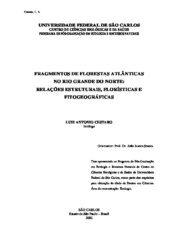Fragmentos de florestas Atlânticas no Rio Grande do Norte: relações estruturais, florísticas e fitogeográficas
Abstract
The knowledge about Brazilian Atlantic forests in its northerm limit of distribution, in the transition to Caatingas, is will very scarce, mainly in the Rio Grande do Norte State, were the small and rare forest fragments still existing are almost totally ecological and phytogeographically ignored. We suppose that this fragments occurs on sandy, dystrophic and deep soils and that the rain gradient is the main factor to determinate different patterns of vegetation types in the east-west direction. The aims of this work are to characterize floristic and structurally the tree layer of four forest fragments ant to determine its relationships
with the nearest phytogeographical provinces. Three semi-deciduous and one deciduous fragments were analyzed, all near of the Natal City, almost perpendicular to the coast. Two fragments, a semi-deciduous and the deciduous, were stretched in two parts according to the relief differences. The point-centered quarter method was used to sample, in the six areas, the standing and living trees with stem perimeter at 1,3 m heigth equal or superior to 10 cm. To each tree
were considered: the species name, height estimated, stem perimeter(s) and the distance to the point. Data were worked at spreadsheets to obtain total density, specific and total basal areas and relatives frequency, density, dominance, importance value and dominance value, H'diversity and J' equability were obtained to each area. To a semi-deicuous forest and to the deciduous one the proportion of species connected to different phytogeographical provinces was obtained. The structure and the floristic composition of the areas were compared. The structure, by means of tree heights, stem diameter and basal area and the floristic composition, by means of Sorensen and Czekanowski similarity indices. Cluster analysis (UPGMA) was used to classify the areas. In all areas 117 species were observed, being 89 in the semi-deciduous forest and 66 in the deciduous forest. Fabaceae and Mytaceae are the richest families. The tree densities vary from 2403 to 1526 individual/ha. The semi-deciduous forests generally are tallest and have a biggest basal area (from 22,29 to 39,84 m2/ha) than deciduous forest, with a basal area of 15,87 m2/ha. The diversity vary between 2,8 and 3,27 nat/individual and the equability between 0,77 and 0,82 to the semi-deciduous forests, while to the deciduous forest the H' values are 3,19 and 3,26 nat/individual and the j' values are 0,79 snf 0.86. Two floristic groups were obtained by classification. One compounded by semi-deciduous forests and another with the deciduous one. The semi-deciduous forests have the highest proportion of species associated to the Atlantic province and a high proportion of wide distribution. Neotropical species, especially in the gallery forests of the Cerrados. Few species are shared with the Caatingas. The deciduous forest
has similiar proportions of species from Atlantic, Caatingas provinces of wide distribution species, being considered as transitional vegetation between the first two provinces. The rain gradient determines the distinction of semi-deciduous forest from the deciduous one, while the edaphic and geomorphologic factos are responsible by different semi-deciduous forest types. The floristic and structural variability observed in a semi-deciduous fragment is associated to the relief and soil variations, being the upper area a transition to the coastal "tabuleiros" savannas, while the lower area, a transition to the gallery forest. The deciduous forest presents low structural internal variability, but with typical species of dry forests in the upper area and typical species of Caatingas in the lower area. The results point out the complexity of the vegetational mosaic in the transitional area between Atlantic and Caatingas provinces in the
Rio Grande do Norte State
